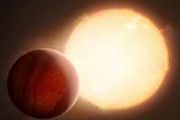
Copernical Team
Momentus' Vigoride-6 spacecraft arrives at SpaceX launch site
 Momentus Inc. (NASDAQ: MNTS) reports that its Vigoride Orbital Service Vehicle (OSV) arrived at Vandenberg Space Force Base for its third demonstration mission targeted to launch on the SpaceX Transporter-7 mission next month.
The Momentus team completed final flight preparations, and the Vigoride-6 OSV is integrated with the Falcon 9 launch vehicle. The priorities of this mission include
Momentus Inc. (NASDAQ: MNTS) reports that its Vigoride Orbital Service Vehicle (OSV) arrived at Vandenberg Space Force Base for its third demonstration mission targeted to launch on the SpaceX Transporter-7 mission next month.
The Momentus team completed final flight preparations, and the Vigoride-6 OSV is integrated with the Falcon 9 launch vehicle. The priorities of this mission include NASA's Small Spacecraft Technology State of the Art Report
 In January 2023, NASA published the latest edition of the State of the Art in Small spacecraft Technology report. It is noteworthy that at the time of the first edition of this report in 2013, only 247 CubeSats and 105 other non-CubeSat small spacecraft under 50 kilograms (kg) had been launched worldwide.
This represented less than 2% of the total mass launched into orbit over multiple yea
In January 2023, NASA published the latest edition of the State of the Art in Small spacecraft Technology report. It is noteworthy that at the time of the first edition of this report in 2013, only 247 CubeSats and 105 other non-CubeSat small spacecraft under 50 kilograms (kg) had been launched worldwide.
This represented less than 2% of the total mass launched into orbit over multiple yea Rutgers scientists identify substance that may have sparked life on earth
 A team of Rutgers scientists dedicated to pinpointing the primordial origins of metabolism - a set of core chemical reactions that first powered life on Earth - has identified part of a protein that could provide scientists clues to detecting planets on the verge of producing life.
The research, published in Science Advances, has important implications in the search for extraterrestrial li
A team of Rutgers scientists dedicated to pinpointing the primordial origins of metabolism - a set of core chemical reactions that first powered life on Earth - has identified part of a protein that could provide scientists clues to detecting planets on the verge of producing life.
The research, published in Science Advances, has important implications in the search for extraterrestrial li Alaska study compares ground motion from satellites and seismic records
 When it comes to making a rapid estimate of ground motion and moment magnitude for an earthquake, using data from Global Navigation Satellite Systems (GNSS) might be a good alternative or addition to data from seismic stations.
Researchers were able to compare how well each type of data performed in assessing the 2021 magnitude 8.2 Chignik earthquake in Alaska, as they report in the journa
When it comes to making a rapid estimate of ground motion and moment magnitude for an earthquake, using data from Global Navigation Satellite Systems (GNSS) might be a good alternative or addition to data from seismic stations.
Researchers were able to compare how well each type of data performed in assessing the 2021 magnitude 8.2 Chignik earthquake in Alaska, as they report in the journa NASA virtual event showcases agency's efforts to transform aviation
 NASA held a virtual showcase last week to demonstrate the agency's efforts in transforming aviation to become more innovative and sustainable. The event called ImaginAviation focused on different areas of aerospace development, featuring NASA's subject matter experts in each area.
One of the focus areas of the event was the use of drones for disaster response, specifically for persistent w
NASA held a virtual showcase last week to demonstrate the agency's efforts in transforming aviation to become more innovative and sustainable. The event called ImaginAviation focused on different areas of aerospace development, featuring NASA's subject matter experts in each area.
One of the focus areas of the event was the use of drones for disaster response, specifically for persistent w Agmatix partners with NASA Harvest to support sustainable agricultural
 Agmatix, a start-up AgTech business specializing in turning agronomic big data into powerful models and insights, has announced a partnership with NASA Harvest - NASA's global Food Security and Agriculture Consortium - to support crop production in a sustainable way at the field level and mitigate the impact of climate change.
A combination of ground sampling and remote sensing data will b
Agmatix, a start-up AgTech business specializing in turning agronomic big data into powerful models and insights, has announced a partnership with NASA Harvest - NASA's global Food Security and Agriculture Consortium - to support crop production in a sustainable way at the field level and mitigate the impact of climate change.
A combination of ground sampling and remote sensing data will b QuSecure conducts quantum-resilient cryptographic communication link through space
 QuSecure, Inc., a leader in post-quantum cybersecurity, has announced that the company has accomplished the first known live, end-to-end quantum-resilient cryptographic communications satellite link through space, marking the first time U.S. satellite data transmissions have been protected from classical and quantum decryption attacks using post-quantum cryptography (PQC).
The quantum-secu
QuSecure, Inc., a leader in post-quantum cybersecurity, has announced that the company has accomplished the first known live, end-to-end quantum-resilient cryptographic communications satellite link through space, marking the first time U.S. satellite data transmissions have been protected from classical and quantum decryption attacks using post-quantum cryptography (PQC).
The quantum-secu Rensselaer researcher breaks through the clouds to advance satellite communication
 Rensselaer Polytechnic Institute's Moussa N'Gom, assistant professor of physics, applied physics, and astronomy, has devised a method to make communications between satellites and the ground more effective no matter the weather. In research recently published, N'Gom and his team used ultrafast, femtosecond lasers to cut through the clouds and rain that commonly cause losses in free-space optical
Rensselaer Polytechnic Institute's Moussa N'Gom, assistant professor of physics, applied physics, and astronomy, has devised a method to make communications between satellites and the ground more effective no matter the weather. In research recently published, N'Gom and his team used ultrafast, femtosecond lasers to cut through the clouds and rain that commonly cause losses in free-space optical Keysight introduces 2 GHz real-time spectrum analysis solution for satellite operators
 Keysight Technologies has released a real-time spectrum analysis (RTSA) solution enabling up to 2 GHz RTSA bandwidth for use with the Keysight N9042B UXA Signal Analyzer. The software-based RTSA solution monitors satellite signals and interference, allowing satellite network operators to provide the highest quality of service (QoS) to users.
As the satellite communications (SATCOM) industr
Keysight Technologies has released a real-time spectrum analysis (RTSA) solution enabling up to 2 GHz RTSA bandwidth for use with the Keysight N9042B UXA Signal Analyzer. The software-based RTSA solution monitors satellite signals and interference, allowing satellite network operators to provide the highest quality of service (QoS) to users.
As the satellite communications (SATCOM) industr HawkEye 360's latest satellite cluster begins operation
 HawkEye 360 has reports its Cluster 6 satellites have begun operation. The rapidly growing constellation can collect up to 24 times per day over a region of interest, as often as once every hour. The enhanced payloads and an additional ground station optimizes the speed for delivering increased quantity and quality of data to customers around the world.
"The continued expansion of our RF-s
HawkEye 360 has reports its Cluster 6 satellites have begun operation. The rapidly growing constellation can collect up to 24 times per day over a region of interest, as often as once every hour. The enhanced payloads and an additional ground station optimizes the speed for delivering increased quantity and quality of data to customers around the world.
"The continued expansion of our RF-s 































